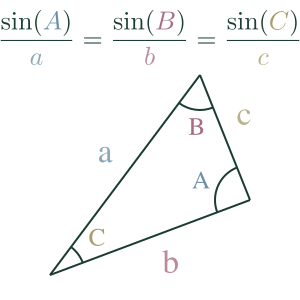The Law of Sines tells us that the ratio between the sine of an angle and the side opposite will be constant for any angle in a triangle.
asinA=bsinB=csinC
If we have at least two sides and an angle or two angles and a side, we can use it to find the missing values.
Example
Question
Consider a triangle with angles A, B and C and sides a, b and c, where a is the side opposite A, b opposite B and c opposite C.
If C=42°, c=15cm and b=1cm, solve the triangle.
Working
We can start by finding B using the Law of Sines:
Since we know that 15cmsin42°=1cmsinB
We can calculate 15sin42°=0.0446
1sinB=0.0446
Since dividing by 1 equals the numerator, we know:
sinB=0.0446
Then use arcsin to find B
B=arcsin(0.0446)
B=2.557°
We can now find A since we know that all the angles in a triangle add up to 180°
A=180°−42°−2.56°
A=135.44°
Now to find a, we can use the Law of Sines again:
15cmsin42°=asin(135.44)
Calculate the known values:
0.0446=0.702/a
Multiply both sides by A:
a×0.0446=0.702
a=0.04460.702=15.74cm
Now that we have the missing values, we can use the Law of Sines to check that all ratios are equal:
15.74sin(135.44°)=0.045
1sin(2.56°)=0.045
15sin(42°)=0.045
Answer
A=135.44°
B=2.56°
C=42°
a=15.74cm
b=1cm
c=15cm
See also Law Of Cosines.
Backlinks
